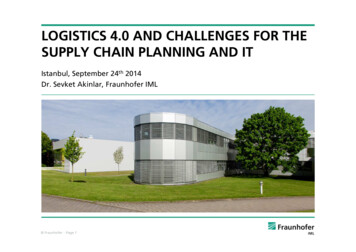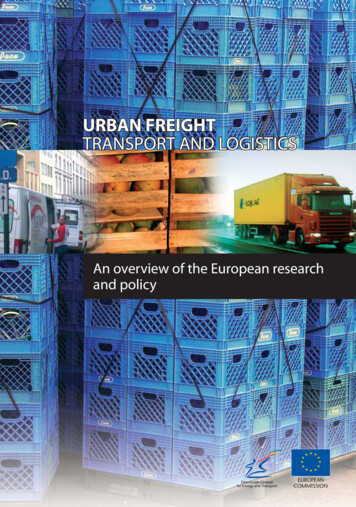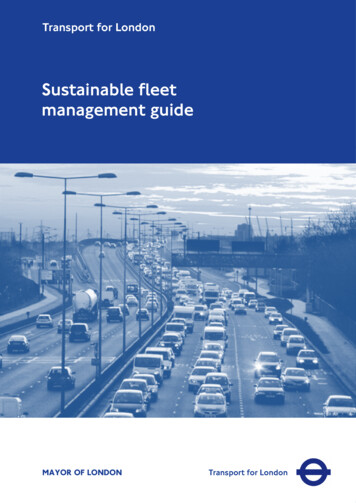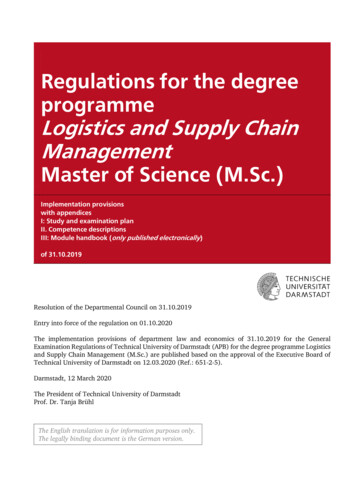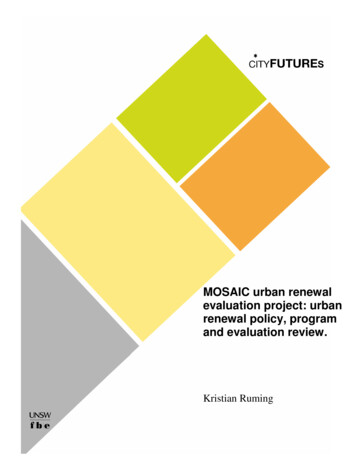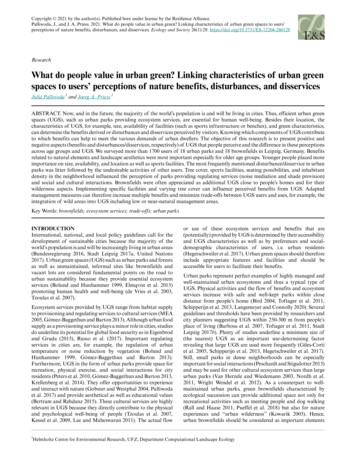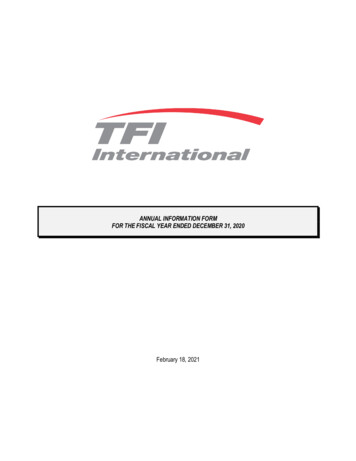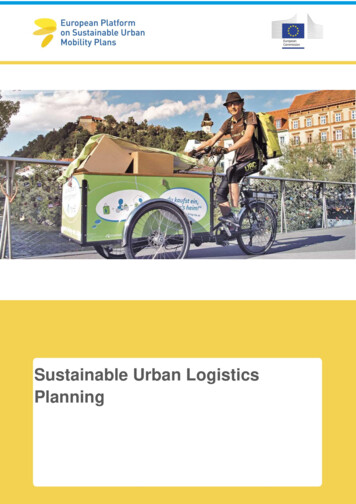
Transcription
Topic Guide Title Sustainable Urban LogisticsPlanning1
Topic Guide Title IMPRINTAboutThis Topic Guide has been developed in the framework of the NOVELOG project, being funded by theEuropean Union’s Horizon 2020 Research and Innovation programme under Grant Agreement no636626 (NOVELOG)TitleDevelop and Implement a Sustainable Urban Logistics Plan (SULP)Author(s)Dr. Georgia Aifandopoulou (NOVELOG Project Coordinator Research Director – Deputy Director HIT, Head ofUnit “ Smart Sustainability-Freight Transport and Networks)Elpida Xenou (Head of Novelog Project Office, Research Associate in HIT/CERTH, Laboratory B4: Intelligentintermodal Freight transport and logistics)ReviewerMans Lindberg, Frederic RudolphAcknowledgementThis publication was made possible thanks to the contributions provided by organizations involved inthe HORIZON 2020 European project NOVELOG, all of whom are credited for their respectivecontributions.DisclaimerThe views expressed in this publication are the sole responsibility of the authors named and do notnecessarily reflect the views of the European Commission.CopyrightAll images in this publication are the property of the organisations or individuals credited. The contentof this publication may be replicated and built upon.Cover picture : City of Graz/Fuhrwerk (in the frame of Novelog Project)ContactsEuropean CommissionDirectorate-General for Mobility and TransportUnit C.1 - Clean transport & sustainable urban mobilityRue Jean-Andre de Mot 28B-1049 BrusselsJune 20192
Sustainable Urban Logistics Planning TABLE OF CONTENTS1.EXECUTIVE SUMMARY . 42.INTRODUCTION . 5EXISTING REGULATORY FRAMEWORK ON SUSTAINABLE AND EFFICIENT URBAN LOGISTICS . 5THE ROLE OF URBAN LOGISTICS IN THE EXISTING SUSTAINABLE URBAN MOBILITY PLAN (SUMP) . 6URBAN LOGISTICS: CONCEPT AND MAIN CHALLENGES . 73.THE 8 SUMP PRINCIPLES IN THE CONTEXT OF ‘A SUSTAINABLE URBAN LOGISTICSPLAN’ . 94.SUSTAINABLE URBAN MOBILITY PLANNING STEPS FOR SULP DEVELOPMENT . 14CONSIDERATIONS FOR SULP DEVELOPMENT APPROACH . 14SULP IMPLEMENTATION STEPS & RECOMMENDATIONS . 15PHASE 1: PREPARATION & ANALYSIS . 16SULP Activity 1.1: Create inter-departmental core team & consider getting external support . 16SULP Activity 1.2: Ensure political and institutional ownership & plan stakeholder and citizeninvolvement. 16SULP Activity 1.3.: Evaluate capacities and resources . 17Step 1’s Checklist: . 19STEP 2: DEFINE THE DEVELOPMENT PROCESS AND SCOPE OF THE PLAN . 20SULP Activity 2.1. : Assess planning requirements and define geographic scope (“functionalurban area”): . 20SULP Activity 2.2: Link with other planning processes . 20SULP Activity 2.3. Involve the stakeholders in the planning process. 20SULP Activity 2.4. Agree time plan and work plan . 21STEP’S 2: CHECKLIST. 21STEP 3: ANALYSE THE CURRENT UFT SITUATION. 22SULP ACTIVITY 3.1.: IDENTIFY INFORMATION SOURCES AND COOPERATE WITH DATA OWNERS . 22SULP ACTIVITY 3.2.: ANALYSE PROBLEMS AND OPPORTUNITIES . 23Step’s 3: Checklist . 24PHASE 2 STRATEGY DEVELOPMENT . 24STEP 4: BUILD AND JOINTLY ASSESS SCENARIOS . 24SULP Activity 4.1. Develop scenarios with citizens and stakeholders . 24SULP Activity 4.2. Discuss scenarios with citizens and stakeholders. 25Step’s 4: Checklist . 25STEP 5: DEVELOP VISION AND OBJECTIVES WITH STAKEHOLDERS . 25SULP Activity 5.1. Agree a common vision of mobility and beyond (input from SUMP Activity 5.1.). 26SULP Activity 5.2. Co-create objectives for all modes with stakeholders . 26Step’s 5: Checklist . 26Step 6 Set targets and indicators . 26SULP Activity 6.1. Identify indicators for all objectives and Agree on measurable targets . 26Step’s 6: Checklist . 27PHASE 3: MEASURE PLANNING . 28STEP 7: SELECT MEASURE PACKAGES WITH STAKEHOLDERS . 283
Sustainable Urban Logistics Planning SULP Activity 7.1. Create and assess measures with stakeholders & Define integrated measurepackages . 28SULP Activity 7.2. Plan measure evaluation and monitoring . 29Step 7 – Checklist . 29STEP 8: AGREE ACTIONS AND RESPONSIBILITIES. 29For the implementation of this step, the city or any interested party can follow the SUMP’sinstructions related to the corresponding SUMP Activity 8.1. . 29SULP Activity 8.2. Estimate costs and identify funding sources . 29SULP Activity 8.3. Agree priorities, responsibilities and timeline . 30SULP Activity 8.4. Ensure wide political and public support . 30For the implementation of this step, the city or any interested party can follow the SUMP’sinstructions related to the corresponding SUMP Activity 8.4. . 30Step 8 – Checklist . 315.LIST OF REFERENCES . 32ANNEX I AGGREGATED SUMP PROCESS FOR SULP . 34ANNEX IΙ UFT DATA & SURVEYS . 37ANNEX III UFT CITY TYPOLOGY & TOOLKIT FOR FINDING UFT MEASURES . 45ANNEX IV UFT BEST PRACTICES . 471. Executive summaryFollowing the official SUMP guidelines developed by the European Platform on SustainableUrban Mobility Plans and published by ELTIS in 2013, lessons have been learned and newpolicy challenges have emerged] regarding the urban mobility planning in various EU-fundedand/or National projects related to Sustainable mobility. Therefore, the existing SUMP conceptis being updated with additional information based on practical experience, new trends andnew good practices in order to form a more comprehensive guidance for SUMPs development.Therefore, revised SUMP guidelines have been developed in an attempt to capitalize on theknowledge and the experience gained in recent years in developing and implementing SUMPsin European cities.One of the issues that has to be addressed in this attempt of attempted update and evolvementis the effective and efficient distribution of goods in cities, in the context of a sustainablemobility policy. Developing Sustainable Urban Logistic Plans (SULPs), in line with the citiesSUMPs, has been the solution followed by some of the cities. The need to allocate specialconsideration to Sustainable Urban Logistics Planning is confirmed by both public and privatestakeholders. Urban Freight Transport is a main contributor to congestion and pollution of thecities city centres, but also a fast-developing industry paramount for the growth of the cities’economic activities. Urban freight transportation (UFT) planning is a complex process, andPublic authorities generally have less knowledge about and capacity regarding specific issuesthan concerning passenger’s mobility, while private companies which are involved inorganizing and implementing urban freight distribution have knowledge of the technicalaspects of the subject. The complexity of a sustainable planning process is even greater sincethe process should a) involve a variety of private actors from a very fragmented environmentwith different and often conflicting needs and goals, b) achieve balance between the industrialrequirement for high efficiency & and low cost operations, and societal requirements for lowCO2 and high safety and sustainability. As a result of the above factors, it is therefore4
Sustainable Urban Logistics Planning challenging to achieve actors’ collaboration and participation in this planning process and toconclude upon measures that can be successful and largely adopted in different urbancontexts.In the context of the above, this topic guide on SULP development aims to provide authoritieswith a framework for a proper implementation of actions, in the context of the SUMPdevelopment, for efficiently addressing the challenges and achieving development of asustainable urban logistics policy and plan which will result in the future sustainabilityexpectations of a city being met. In an effort to provide practical support to readers, thisdocument also provides the best practices of tools, methods and techniques that can be usedin several of the 7 steps of the revised SUMP process, together with the measures andinterventions for best practices.2. IntroductionExisting regulatory framework on sustainable and efficient urban logisticsThe European Union has defined specific policies and guidelines and has begun promotingdedicated tools and platforms for addressing the Urban Freight Transportation (UFT)challenges. In the 2011 White Paper1, a clear strategy for ‘near zero emission urban logisticsby 2030’ was set by the EU, which was followed by several supportive initiatives towards thatdirection, including the Urban Mobility Package (UMP)2, the Low Emission Strategy of 2016,and the three Mobility packages of 2017 and 2018.Moving in that direction, the EU stresses, in the 2011 White Paper as well as in the StaffWorking Document3 accompanying the Urban Mobility Package (UMP)2, the significance ofusing Intelligent Transport Systems (ITS) for optimizing the last mile distribution, which aimsat the complete digitalization of urban freight mobility. This initiative is being supported by theITS Directive4, the establishment of expert working groups (WG17 on Urban-ITS, CEN/TC 278and the Digital Transport and Logistics Forum (DTLF)).The efficient interconnection of long distance and last mile transportation, through theimplementation of urban nodes (being the starting point or the final destination - first/last mile)for passengers and freight moving on the trans-European transport network, is also one of thepriorities of the EU. Moreover, the implementation of measures such as ‘off-peak hoursdeliveries’5, the deployment of alternative fuels infrastructure6, and the use of clean freightvehicles7,8 were also recommended.The latest initiative of the EU on tackling the main UFT challenges and providing clearassistance to the local policy makers was undertaken in 2018 with the publication of a studyon urban logistics – ‘The integrated perspective’– as it was announced in the Communication(2013) 913 final2. This study provided guidelines on six different aspects of urban logistics: 1)‘Use of Information and Communication Technologies’; 2) ‘Treatment of logistics activities in1 European Commission (2011), White Paper, Roadmap to a Single European Transport Area-Towards a competitive and resource efficienttransport system, COM(2011) 144 final2 European Commission (2013b) Urban mobility package. COM(2013) 913 final3 European Commission (2013a) A call to action on urban logistics. SWD(2013) 524 final4 European Parliament, 2010. Directive 2010/40/EU of the European parliament and of the council. Official Journal of the European Union, 50,p.207.5 European Commission (2013), Staff Working Document ,A call for smarter urban vehicle access regulations, Brussels, SWD(2013) 526 final6 European Parliament (2014), Directive 2014/94/EU on the deployment of alternative fuels infrastructure7 European Parliament (2009) Directive (Directive 2009/33/EC) on the promotion of clean and energy-efficient road transport vehicles8 European Commission (2013), Commission Staff Working Document, Guidelines on financial incentives for clean and energy efficient vehicles,Brussels, SWD(2013) 27 final5
Sustainable Urban Logistics Planning Urban Vehicle Access Regulation Schemes’; 3) ‘Engagement of stakeholders whenimplementing urban freight transport policies’; 4) ‘Logistics schemes for E-commerce’; 5) ‘Theuse of Environmentally Friendly Freight’; and 6) ‘Indicators and data collection methods forurban freight distribution’.However, as it was highlighted by the European Economic and Social Committee (EESC)9,the policy framework should focus further on the importance of urban freight transport. TheEESC gave particular emphasis to the inclusion of urban logistics ‘as part of a sustainabletransport policy’, while the European Parliament10 highlights the need for introducing newbusiness models, measures, and technologies for more efficient and effective urban logisticsoperations, thus anticipating the new and constantly evolving trends (Collaborative Economy,Logistics as a Service (LaaS), On-demand Economy. etc.).The role of Urban Logistics in the existing Sustainable Urban Mobility Plan(SUMP)The Sustainable Urban Mobility Plan (SUMP) is a ‘strategic plan designed to satisfy themobility needs of people and businesses in cities and their surroundings for a better quality oflife. The SUMP builds on existing planning practices and takes due consideration ofintegration, participation, and evaluation principles’ (ELTIS 2013). The development andimplementation of Sustainable Urban Mobility Plans has been strongly supported by the EUand the European Parliament (through the 2011 White Paper) as one of the most importanttools that a city can use in order to make the transportation infrastructure and services moreefficient and to improve the integration of different mobility modes in urban areas in asustainable manner.The official guidelines for the development and implementation of sustainable urban mobilityplans were developed by the European Platform on Sustainable Urban Mobility Plans andpublished by ELTIS in 2013. They provided local authorities with a structured approach on howto develop and implement policies and cost-effective measures for achieving a sustainablefuture for their cities. Since then, however, lessons have been learned and new policychallenges have emerged regarding the urban mobility planning in various EU-funded SUMPprojects. Therefore, the existing SUMP concept is being updated with additional informationbased on practical experience, new trends and new good practices in order to form a morecomprehensive guidance for SUMPs development.One of the issues that has to be addressed in this attempted update and evolvement is theeffective and efficient distribution of goods in the city. The complexity of organizing urbanfreight distribution is driven by the vast range of activities resulting from relationships among avariety of actors with different and often conflicting needs and goals, and by a number ofnegative environmental consequences and social effects, such as congestion, air and noisepollution, and an increase of safety hazards. These factors make it difficult for a policy plannerto propose standard measures suitable for different urban contexts, as well as to develop acommon understanding about future expectations.In parallel with the above, the science and practice of UFT and city logistics has beendeveloping, and introducing novel solutions to address issues caused by UFT traffic.9 European Commission (2016), Commission Staff Working Document, The implementation of the 2011 White Paper on Transport "Roadmap to aSingle European Transport Area – towards a competitive and resource-efficient transport system" five years after its publication: achievements andchallenges, Brussels,SWD(2016) 226 final10 European Parliament (2015), Implementation of the 2011 White paper on transport, European Parliament resolution of 9 September 2015 on theimplementation of the 2011 White Paper on Transport: taking stock and the way forward towards sustainable mobility (2015/2005(INI)),P8 TA(2015)03106
Sustainable Urban Logistics Planning Therefore, the present document constitutes an additional guide to the updated SUMP cycleand aims to provide practical assistance to a city on how it should address the urban logisticsaspect in the city’s SUMP, and which tools, methods and techniques can be used for thesuccessful implementation of the 7 first steps of the SUMP process.Urban Logistics: Concept and main challengesUrban freight transportation constitutes a fundamental component in the life of a city.Nowadays, more than 73% of the European population lives in urban areas, while this isexpected to increase to 85% by 2050. This phenomenon of urbanization has resulted inan increasingly higher demand for urban transportation, either for B2B or B2Cpurposes.11Apart from last-mile transportation, UFT involves a vast range of additional processes:handling and storage of goods, inventory management, waste and returns, as well as homedelivery. While many of these processes, or parts of them, are undertaken outside of urbanareas, they continue to have an impact on urban operations.UFT is a for-profit activity, predominantly controlled and operated by private interests. Althoughessential to the functioning of urban economies, due to the fact that UFT makes goodsavailable to customers located in urban areas, its for-profit character is to a large extentresponsible for the fact that public authorities currently have a low understanding of thecommercial dynamics of freight distribution.However, urban freight processes simultaneously involve, not only economic, but also socialand environmental issues, which may possibly result in conflicts. In fact, UFT has a number ofnegative effects in terms of safety, congestion, and air and noise pollution. For instance, inEurope, it UFT is responsible for 25% of urban transport related CO2 emissions and 30-50%of other transport related pollutants12. In addition, a growing urban population, combined withother trends, such as e-commerce and home deliveries development, and together with anageing population, will lead to an increase in demands for goods and services, with aconsequent increase of UFT demand. This in turn will result in the necessary reduction of theeffects of negative externalities. In this regard, the European White Paper has set the goal for‘near zero emission urban logistics by 2030’13. Moving towards a more sustainable urbanfreight system requires changes and innovations both in the public and private sectors.However, the lack of coordination of urban logistics actors and data/information availability,contribute to insufficient urban planning and integration of urban freight into the city’soperations. Within the context of the first EU-USA Transportation Research Symposium,dedicated to city logistics research (May 30–31, 2013), the research community raised theissue of the unavailability or the low quality of data on urban freight. It also stressed the needfor more effective data collection methods and for the identification of the main drivers of theeconomic activity, which is paramount for an understanding of the actors’ behaviour.11United Nations. Around 2.5 Billion More People Will Be Living in Cities by 2050, Projects New UN Report; United Nations Departmentof Economic Social Affairs: New York, NY, USA, 2018.12 ALICE. Urban Freight Research Roadmap; European Road Transport Research Advisory Council: Brussels, Belgium, 2015.13 European Commission (2011), White Paper, Roadmap to a Single European Transport Area-Towards a competitive and resource efficienttransport system, COM(2011) 144 final7
Sustainable Urban Logistics Planning This lack of awareness on UFT activities can be a serious obstacle when determining theircurrent sustainability and planning and implementing appropriate measures to optimize theseactivities in economic, social and environmental terms.In most cities, city planning and traffic surveys are undertaken exclusively as regards topassenger transport. The most important reasons for this approach are: Urban freight transport is a complex system, made up of numerous activities, and it isnecessary to collect data from a large quantity of economic agents. Shippers and transport operators are reluctant to share information of about theiroperations. Local authorities are not able to understand what kind of data is needed. Collecting and updating urban freight data can be too costly for local authorities.However, in recent years these gaps have been partially filled by the study on urban freight,developed and published by the EU, as mentioned above, as well as by the research outputsand significant contribution of the latest HORIZON 2020 projects14,15 that dealt with citylogistics.The present document aims to address the above mentioned challenges by providing specificguidelines and clear procedures to local policy makers on how to better monitor, control andin general manage the urban logistics activities that take place within their city.14 NOVELOG project (H2020): www.novelog.eu , U-Turn project (H2020):http://www.success-urbanlogistics.eu/, CITYLAB roject.eu SUCCESS project (H2020)8
Topic Guide Title 3. The 8 SUMP principles in the context of ‘a Sustainable UrbanLogistics Plan’Local authorities engage with logistic players and local businesses to come up with innovativestrategies reconciling two potential conflicting elements: a freight distribution system satisfyingthe market demand, and a liveable, emission-free urban environment. This has led to a widerange of initiatives in the following areas: air quality & safety, clean & alternative fleetpromotion, space management and consolidation, data and stakeholder engagement.The process of developing strategies and plan for sustainable urban logistics as part of theSUMP process is the effort of organizing initiatives of public & private stakeholders andachieving efficient & integrated approach for alleviating problems caused by urban freighttransport, while respecting the SUMP principles.City logistics planning requires additional considerations than the passengers mobilityplanning. In urban logistics planning, industrial (business & logistics) stakeholders’requirements should be addressed and their mobilization in the planning process is neededsince their reasoning (based mainly on profitability and efficiency) should also be taken intoaccount during decision making. Also the parameters defining the future vision, objectives andpriorities of a plan for sustainable UFT are different than those used for passenger mobilityplans. Finally, the level of stakeholders’ collaboration, suggested by the SUMP process, isdifficult to be achieved due to the fragmentation of the transport and logistics industry andspecial provisions should be implemented.However, as city logistics is part of the city’s overall mobility landscape, any attempt to studyit in isolation from the general city’s environment, would be wrong. Therefore, in the followingparagraphs considerations related to city logistics planning are discussed in the context ofeach SUMP principles.Principle 1 Plan for sustainable mobility in the 'functional city:Planning for city Logistics may be defined as the process for totally optimizing the logistics andthe transport activities –implemented by private companies- with the support of technologies& collaborative operations, while considering safety and energy savings in urban trafficenvironment. The above should be achieved within the framework of a market economy anda city policy for sustainability.In this context the development & implementation of a Sustainable Urban Logistics Plan aimsto contribute to the SUMPs main purpose for a sustainable mobility system by definingpriorities, measures and implementations of new operations for improving the effectiveness ofcity logistics in the entire functional urban area.The opinion that a SULP could (depending on the size and the complexity) be developed as aseparated and integrated to the SUMP document is based on the fact that SULP should include(as also the SUMP) dedicated and separated guidance on how to: Understand the current situation of the city’s urban freight transportation and logistics Involve the UFT stakeholders in city logistics planning Identify the most appropriate Urban Freight Transportation solutions based on eachcity’s typology Develop sustainable, cost effective and economic viable solutions and urban freighttransportation strategies9
Sustainable Urban Logistics Planning Measure the performance of a UFT solutionCity authorities when plan for urban freight transport sustainability, should take into accountthat urban distribution is a facilitator of the supply chain vitality, economic development andbusiness prospects and it is important for ensuring the continuous and stable operation oflarge-scale freight transport activities between suppliers and consumers in urban areas.Important infrastructure, organization capacity and the services of these operations may belocated outside the city limits. Therefore, the definition of the functional area for the sustainableurban logistics planning should be based on the knowledge of the typology of the supply chainsemerging in the urban area, the characteristics of freight flows and of the transport & logisticssupply.Principle 2-Develop a long-term vision and a clear implementation plan:The city’s approach to sustainable city logistics that will result from the SULP developmentprocess should be in line with the SUMP’s long term vision which needs to be customized forfreight transportation. Following the definition of the city’s vision, the SULP will be structuredaround short and medium term measures and interventions for achieving implementation ofthe strategy. The implementation plan will identify the resources and tools that are needed, willdefine the roles and responsibilities of private and public stakeholders, and will set the timeplan and budget allocation.During the urban freight transport scenarios development and the measures selections, cityauthorities should consider trends for new or innovative city logistics solutions that are pursuedby the transport & logistic industry. Although city logistics is a relatively new area of urbanstudy and urban management, city logistics measures, including co-operative freight transportsystems, consolidated city distribution centres & micro consolidation, advanced vehicle routingand scheduling using intelligent transport systems, load factor controls, road pricing, intelligentparking controls, pickup points for e-commerce, drones for last mile deliveries etc., havealready being implemented around Europe.Principle 3 Assess current and future performance:Similarly to the SUMP process, the SULP development focuses on achieving the primary andsecondary objectives set by a city which are aligned with the vision of mobility and urban freighttransportation.In order for the city p
document also provides the best practices of tools, methods and techniques that can be used in several of the 7 steps of the revised SUMP process, together with the measures and interventions for best practices. 2. Introduction Existing regulatory framework on sustainable and efficient urban logistics The European Union has defined specific policies and guidelines and has begun promoting .
